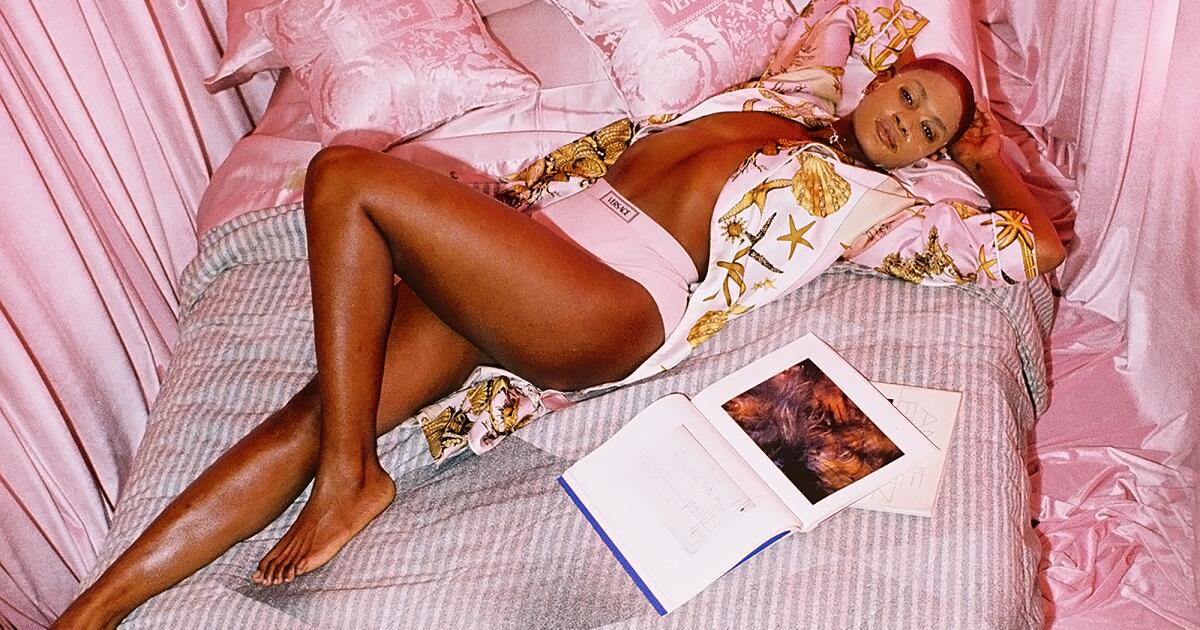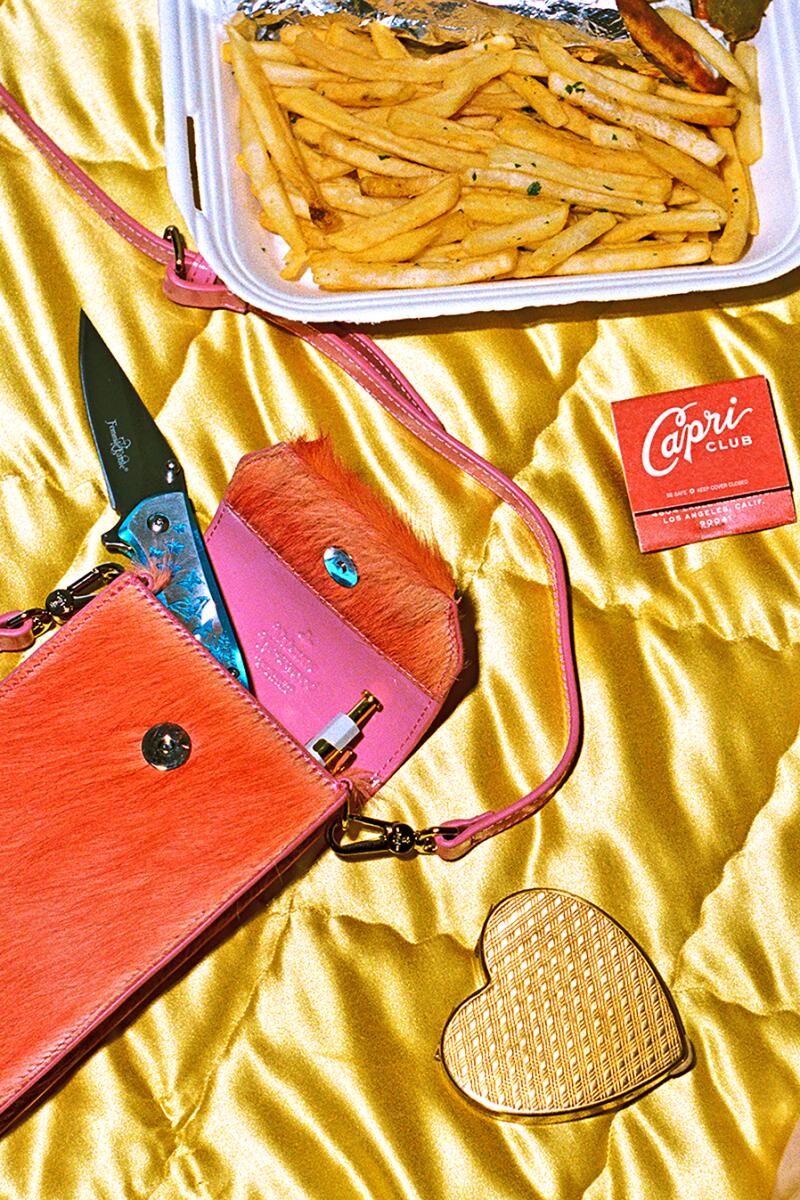Lifestyle
The benefits of dressing up to stay in — and why they outweigh dressing up to go out

I only sleep in silk. It’s a bit of a dirty secret.
This isn’t the type of thing you want to admit to a friend, much less a stranger. It’s undemocratic. Polyester isn’t good enough for you? Rayon, viscose, all the leaps and bounds made in synthetics — don’t you believe in science?
Fine silk runs through the fingers like soft water. It drapes without hiding your lines or curves — but can, if woven with enough heft, still deliver on structure. In the right color, it is impervious to sweat. With a little Woolite — and the stomach to ignore the tsk-tsk of “dry clean only” — it’ll survive a hundred washings. Silk comforts and cocoons, so light it practically hovers. I sleep in silk. I cook in silk. I clean in silk. I live in silk — it’s all I wear when I’m at home. (And, often, an apron.) Why dress up to go out when you can dress to stay in?
Pamela wears Versace briefs and robe , Justine Clenquet earrings and necklace.

Louis Vuitton pajamas, Justine Clenquet earrings.
Like many immigrant families, the one I grew up in drew a hard line between inside clothes and outside clothes. (Or maybe it’s not about hyphens but just having some manners; as Phoebe Robinson says, “Please Don’t Sit on My Bed in Your Outside Clothes.”) Outside, the world is covered in dog s—. Plus a good deal of pollen that will have me up all night hacking. Inside, my bare feet walk on the qilim my mother “lent” me 15 years ago, and the air’s laced with cardamom from my decaf-black virgin nightcap. Inside, there’s a candle burning and a ban on overhead lighting. Inside, one rule reigns: respect the sanctity of Inside.
Pajamas, you see, aren’t just for sleeping. They’re inside clothes. This is a lesson the pandemic brought home to everyone, but for some of us it’s always been so.
The word “pajama” stems from Persian/Farsi, as I learned in my medieval Persian seminar in college after a life of speaking Farsi at home but somehow never registering the echo of this particular cognate. A compound of “pay,” or leg, and “jāma,” cloth (as in, clothes), the term first traveled to India via the Mughals, who spoke Persian at court. We’re talking the 1500s. A few centuries later — as a Dolce & Gabbana blog post on “the pyjama” also so kindly explains — the word, and corresponding style of loose pants coupled with a matching top, then went West via the Raj: colonial Brits stole the breezy unisex look from their subjects. In short, as an Iranian, I come from a long uninterrupted line of pajamas. Though probably in cotton.
When I was a kid, I also had a few nightgowns. My favorite my mother had sewn for me. Puff sleeves, peach and brown stripes. Memorialized, these days, in a snapshot of me and my childhood best friend on her family’s pullout couch, Nick at Nite on the TV.
Historically, nightgowns, opposite from pajamas, traveled from West to East. And they didn’t start out femme — in medieval Europe, men and women alike retired for the night in long, loose shirts. Today nightgowns are pretty much dead. But there was a time when Dior could dress you so good in lace and pastels it’d make you want to wear makeup to bed. Now few luxury brands bother, including Dior. (Albeit the occasional exception, like this truly wild floor-length, rhinestone-encrusted sheer getup by Dolce & Gabbana.) Probably for the same reason, I no longer have any nightgowns. First Wave feminism-slash-medieval Muslim culture has finally crashed on the shores of fashion, and women wear pants. Dresses can be restrictive. I like to lounge with one leg up.
Since those childhood days of puffs sleeves past, I’ve accrued a small collection of adult pajama sets. Window-shopping for my next set, I come back across the garment’s colonial lineage. A matching set by Dior — clearly I’m dreaming — features a generic jungle scene as the house’s take on Toile de Jouy (i.e., fussy French pastoral). Prints of “exotic” flora and fauna have become such a mainstay of luxury pajamas (see: Olivia von Halle) that we don’t even notice the history behind them. I’m not calling for a boycott, but every now and then, I like to see how the sausage gets made.
Inside you are your main audience. The joy lies in the freedom. Be extra. Go bold.
Me, I like it simple. But always in silk.

Pamela wears Agent Provocateur lingerie, Wolford stockings.

Vivienne Westwood phone purse.
My first set of silk pajamas came relatively late in life. Christmas in Fort Greene, my mid-20s. It was snowing. The kind of snow that feels like the first snow even when it isn’t, those light bright flakes that hang in the air so mournfully and beautifully you’d think you were on set for the holiday special except you can feel them melting on your chapped lips. There were so many firsts that year. My first apartment shared by an “us” that wasn’t simply financial, wasn’t me and a roommate. My first — in the form of our first — Christmas tree. (I didn’t grow up celebrating.) And, surely just as momentous, my first foray into pure silk.
Black silk with black piping. Fat black buttons, curved lapels. Long sleeves, long pants. Men’s. We’d gone Christmas shopping in the snow at the Brooklyn flea. When the scrawny guy draped over a folding chair across the stall saw me thumbing the package, he assured me that all his “girlfriends” wore them in an S, as if I needed an excuse to shop menswear and women only came in one size. He quoted 50 dollars for the set, a price that seemed at once fair and substantial. Back in the apartment that night, too lazy to iron out folds creased by time, I let more time and the wet heat of my body shake out the fabric.
Going silk is like what I imagine it felt like to step into the ’70s and burn (i.e., toss) your bras — there’s no way back. Now I have silk for every season — just a piece or two. Princesse tam tam cami and shorts in cherry red — not the skin but the flesh, which is redder. Another Princesse tam tam cami (black, bustle button detail) whose matching bottom I spent hours searching for in vain (such are sales). Thrifted and gifted to my beau before I took it back, a silk men’s tee by Cos big enough to serve as a micro-dress. Actually gifted to myself for a pandemic birthday, a classic Sleeper set in high-shine satin, the color an indulgence in itself: cream, as in farm-fresh and organic. And, I must say, way too high-maintenance. Like after I’ve done my own mani — for hours, I can hardly lift a finger without fear of effing something up.
True luxury lies in ease. As in donning that old black pajama set, day after gray rainy day, this past L.A. winter. Silk lasts. After over a decade of sitting cross-legged on the sofa in these silk pajama pants, reading or watching something; after over a decade of tossing and turning in them as I made and remade myself in cities and careers that were miles and miles apart; after over a decade of washing them, not by hand like my other silks, but by throwing them in the monstrous machine at the laundromat with regular detergent, and yes, sometimes, even machine-drying them (come out soft as a caterpillar) — after over a decade of use and abuse, I only just recently had to have a couple seams resewn. This stuff is ox-strong. Twelve years of sweat and soap, and now when the fabric ripples, black fades to gray, thick with light. You can’t buy patina like this.
Clothes are our closest homes, our first layers of shelter. I guess most folks think they’re only worth investing in when there are strangers to impress. But I want to say that being inside, being alone, is important. Maybe you’re no raja or rani, but your skin might like the touch of silk.

Pamela wears Vivienne Westwood corset, vintage purple briefs, Justine Clenquet choker.
Production: Mere Studios
Model: Pamela Holmes
Prop stylist: Gina Caravan
Makeup: Carla Perez
Photo assistant: Nicholas Mora
Prop assistant: Jessica Ayala
Mariam Rahmani is a writer and translator. Her first novel, “Liquid, A Love Story,” comes out in March from Algonquin. It takes place between L.A. and Tehran.

Lifestyle
Wait Wait… Don't Tell Me!

Lifestyle
Tell us: What's the most extraordinary West Coast experience?

Our guide to the 101 best West Coast experiences brings you essential things to do in Baja, California, Oregon, Washington and British Columbia. We think it has something for every type of explorer, from the awe-seeking (a hike around the rim of a sleeping volcano at Crater Lake) to the nostalgic (burgers alongside classic cars at the oldest Bob’s Big Boy) to the unabashedly extravagant (a stay at San Diego’s maximalist LaFayette Hotel).
Of course, you may have your own favorite adventure that didn’t make the list. We’d love to hear about it. In the form below, tell us what you believe is the most extraordinary experience or destination on the West Coast and why it resonates with you. It can be as simple as a single bench with a view or as vast as a life-changing road trip. We may feature your response in a future story.
Lifestyle
Dabney Coleman, who starred in '9 to 5' and 'Tootsie', dies at 92

Dabney Coleman, who starred in “9 to 5” and “Tootsie,” appears in Los Angeles on Nov. 14, 1988. The actor died Thursday at his home in Santa Monica, Calif.
Nick Ut/AP
hide caption
toggle caption
Nick Ut/AP

Dabney Coleman, who starred in “9 to 5” and “Tootsie,” appears in Los Angeles on Nov. 14, 1988. The actor died Thursday at his home in Santa Monica, Calif.
Nick Ut/AP
NEW YORK — Dabney Coleman, the mustachioed character actor who specialized in smarmy villains like the chauvinist boss in “9 to 5” and the nasty TV director in “Tootsie,” has died. He was 92.
Coleman died Thursday at his home in Santa Monica, his daughter, Quincy Coleman, said in a statement to The Associated Press. She said he “took his last earthly breath peacefully and exquisitely.”
“The great Dabney Coleman literally created, or defined, really — in a uniquely singular way — an archetype as a character actor. He was so good at what he did it’s hard to imagine movies and television of the last 40 years without him,” Ben Stiller wrote on X.
For two decades Coleman labored in movies and TV shows as a talented but largely unnoticed performer. That changed abruptly in 1976 when he was cast as the incorrigibly corrupt mayor of the hamlet of Fernwood in “Mary Hartman, Mary Hartman,” a satirical soap opera that was so over the top no network would touch it.

Producer Norman Lear finally managed to syndicate the show, which starred Louise Lasser in the title role. It quickly became a cult favorite. Coleman’s character, Mayor Merle Jeeter, was especially popular and his masterful, comic deadpan delivery did not go overlooked by film and network executives.
A six-footer with an ample black mustache, Coleman went on to make his mark in numerous popular films, including as a stressed out computer scientist in “War Games,” Tom Hanks’ father in “You’ve Got Mail” and a fire fighting official in “The Towering Inferno.”
He won a Golden Globe for “The Slap Maxwell Story” and an Emmy Award for best supporting actor in Peter Levin’s 1987 small screen legal drama “Sworn to Silence.” Some of his recent credits include “Ray Donovan” and a recurring role on “Boardwalk Empire,” for which he won two Screen Actors Guild Awards.
In the groundbreaking 1980 hit “9 to 5,” he was the “sexist, egotistical, lying, hypocritical bigot” boss who tormented his unappreciated female underlings — Jane Fonda, Lily Tomlin and Dolly Parton — until they turned the tables on him.
In 1981, he was Fonda’s caring, well-mannered boyfriend, who asks her father (played by her real-life father, Henry Fonda) if he can sleep with her during a visit to her parents’ vacation home in “On Golden Pond.”
Opposite Dustin Hoffman in “Tootsie,” he was the obnoxious director of a daytime soap opera that Hoffman’s character joins by pretending to be a woman. Among Coleman’s other films were “North Dallas Forty,” “Cloak and Dagger,” “Dragnet,” “Meet the Applegates,” “Inspector Gadget” and “Stuart Little.” He reunited with Hoffman as a land developer in Brad Silberling’s “Moonlight Mile” with Jake Gyllenhaal.
Coleman’s obnoxious characters didn’t translate quite as well on television, where he starred in a handful of network comedies. Although some became cult favorites, only one lasted longer than two seasons, and some critics questioned whether a series starring a lead character with absolutely no redeeming qualities could attract a mass audience.
“Buffalo Bill” (1983-84) was a good example. It starred Coleman as “Buffalo Bill” Bittinger, the smarmy, arrogant, dimwitted daytime talk show host who, unhappy at being relegated to the small-time market of Buffalo, New York, takes it out on everyone around him. Although smartly written and featuring a fine ensemble cast, it lasted only two seasons.
Another was 1987’s “The Slap Maxwell Story,” in which Coleman was a failed small-town sportswriter trying to save a faltering marriage while wooing a beautiful young reporter on the side.
Other failed attempts to find a mass TV audience included “Apple Pie,” “Drexell’s Class” (in which he played an inside trader) and “Madman of the People,” another newspaper show in which he clashed this time with his younger boss, who was also his daughter.
He fared better in a co-starring role in “The Guardian” (2001-2004), which had him playing the father of a crooked lawyer. And he enjoyed the voice role as Principal Prickly on the Disney animated series “Recess” from 1997-2003.
Underneath all that bravura was a reserved man. Coleman insisted he was really quite shy. “I’ve been shy all my life. Maybe it stems from being the last of four children, all of them very handsome, including a brother who was Tyrone Power-handsome. Maybe it’s because my father died when I was 4,” he told The Associated Press in 1984. “I was extremely small, just a little guy who was there, the kid who created no trouble. I was attracted to fantasy, and I created games for myself.”
As he aged, he also began to put his mark on pompous authority figures, notably in 1998’s “My Date With the President’s Daughter,” in which he was not only an egotistical, self-absorbed president of the United States, but also a clueless father to a teenager girl.
Dabney Coleman — his real name — was born in 1932 in Austin, Texas After two years at the Virginia Military Academy, two at the University of Texas and two in the Army, he was a 26-year-old law student when he met another Austin native, Zachry Scott, who starred in “Mildred Pierce” and other films.
“He was the most dynamic person I’ve ever met. He convinced me I should become an actor, and I literally left the next day to study in New York. He didn’t think that was too wise, but I made my decision,” Coleman told The AP in 1984.
Early credits included such TV shows as “Ben Casey,” “Dr Kildare,” “The Outer Limits,” “Bonanza,” “The Mod Squad” and the film “The Towering Inferno.” He appeared on Broadway in 1961 in “A Call on Kuprin.” He played Kevin Costner’s father on “Yellowstone.”
Twice divorced, Coleman is survived by four children, Meghan, Kelly, Randy and Quincy, and the grandchildren Hale and Gabe Torrance, Luie Freundl and Kai and Coleman Biancaniello.
“My father crafted his time here on earth with a curious mind, a generous heart, and a soul on fire with passion, desire and humor that tickled the funny bone of humanity,” Quincy Coleman wrote in his honor.
-

 Finance1 week ago
Finance1 week agoSpring Finance Forum 2024: CRE Financiers Eye Signs of Recovery
-

 World1 week ago
World1 week agoIndia Lok Sabha election 2024 Phase 4: Who votes and what’s at stake?
-

 Politics1 week ago
Politics1 week agoBiden’s decision to pull Israel weapons shipment kept quiet until after Holocaust remembrance address: report
-

 News1 week ago
News1 week agoTornadoes tear through the southeastern U.S. as storms leave 3 dead
-

 News1 week ago
News1 week agoThe Major Supreme Court Cases of 2024
-

 World1 week ago
World1 week agoA look at Chinese investment within Hungary
-

 Politics1 week ago
Politics1 week agoTales from the trail: The blue states Trump eyes to turn red in November
-

 World1 week ago
World1 week agoBorrell: Spain, Ireland and others could recognise Palestine on 21 May















